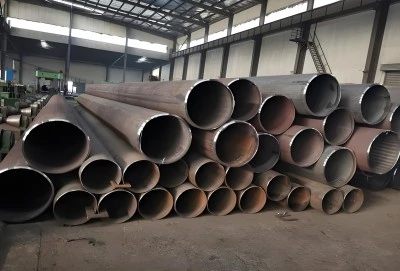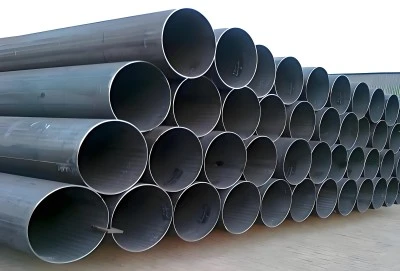In the world of steel piping, understanding the differences between various specifications is crucial for selecting the right material for your project. Two commonly compared specifications are ASTM A53 and ASTM A135 pipes. While they may seem similar at first glance, these pipes have distinct characteristics that make them suitable for different applications. In this comprehensive guide, we'll explore the key differences between A53 and A135 pipes, their chemical compositions, preferred applications, and how the Electric Resistance Welding (ERW) manufacturing process affects each type.
|
|
|
Chemical Composition: A53 vs. A135 Pips
The chemical composition of steel pipes plays a significant role in determining their properties and performance. Let's examine how A53 and A135 pipes differ in this aspect:
ASTM A53 Pipe Composition:
ASTM A53 pipes are available in three grades: A, B, and C. The chemical composition varies slightly between these grades, but generally includes:
- Carbon: 0.25% max (Grade A), 0.30% max (Grade B)
- Manganese: 0.95% max (Grade A), 1.20% max (Grade B)
- Phosphorus: 0.05% max
- Sulfur: 0.045% max
ASTM A135 Pipe Composition:
Two grades: A and B. The chemical composition for Grade B includes:
- Carbon: 0.30% max
- Manganese: 1.20% max
- Phosphorus: 0.05% max
- Sulfur: 0.045% max
As we can see, the chemical compositions of A53 Grade B and A135 Grade B are quite similar. However, there are some key differences:
- A53 pipes have more stringent requirements for carbon and manganese content, which can affect the pipe's strength and weldability.
- A135 pipes may have slightly higher tolerances for certain elements, allowing for more flexibility in the manufacturing process.
- A53 pipes are available in more grades, providing a wider range of options for different applications.
These subtle differences in chemical composition contribute to the distinct properties and applications of each pipe type.
Preferred Applications: When to Choose A135 over A53
While both A53 and A135 pipes are used in various industries, they each have specific applications where they excel. Understanding these preferences can help you make the right choice for your project:
ASTM A53 Pipe Applications:
A53 pipes are known for their versatility and are commonly used in:
- General-purpose piping systems
- Oil and gas transportation
- Water and sewage systems
- Structural applications
- Low-pressure steam lines
- Air and gas lines
A53 pipes are preferred in these applications due to their excellent strength, durability, and ability to withstand various pressures and temperatures.
ASTM A135 Pipe Applications:
A135 pipes, particularly the ASTM A135 pipe, are specifically designed for fire protection systems and are preferred in:
- Automatic sprinkler systems
- Standpipe systems
- Fire protection water mains
- Other fire suppression applications
The ASTM A135 pipe is favored in these applications for several reasons:
- Consistent quality: A135 pipes undergo rigorous testing to ensure reliability in fire protection systems.
- Pressure resistance: These pipes are designed to withstand the high pressures often encountered in fire suppression systems.
- Corrosion resistance: A135 pipes typically have good corrosion resistance, which is crucial for long-term reliability in fire protection systems.
- Cost-effectiveness: For fire protection applications, A135 pipes often provide a more economical solution compared to other options.
While A53 pipes can be used in some fire protection applications, A135 pipes are specifically engineered and tested for this purpose, making them the preferred choice in many cases.
ERW Manufacturing Process: Impact on A53 and A135 Pipes
Both A53 and A135 pipes can be manufactured using the Electric Resistance Welding (ERW) process. However, the ERW process affects these pipes differently due to their distinct specifications and intended applications:
ERW Process for A53 Pipes:
- Material preparation: Steel coils are carefully selected based on the required chemical composition for A53 pipes.
- Forming: The steel is formed into a tubular shape using rollers.
- Welding: High-frequency electric current is applied to heat the edges of the formed steel, which are then pressed together to create a strong weld.
- Heat treatment: A53 pipes often undergo heat treatment to relieve stress and improve mechanical properties.
- Testing: The pipes are subjected to various tests, including hydrostatic pressure tests, to ensure they meet A53 specifications.
The ERW process for A53 pipes focuses on achieving a balance between strength, ductility, and weldability to suit their wide range of applications.
ERW Process for A135 Pipes:
- Material selection: Steel with the appropriate chemical composition for A135 pipes is chosen.
- Forming and welding: Similar to A53 pipes, the steel is formed and welded using the ERW process.
- Specialized heat treatment: A135 pipes may undergo specific heat treatment processes to enhance their fire resistance properties.
- Rigorous testing: ASTM A135 pipes are subjected to additional tests focused on their performance in fire protection systems.
- Quality control: Strict quality control measures are implemented to ensure consistent performance in fire suppression applications.
The ERW process for A135 pipes, particularly ASTM A135 pipe, is tailored to produce pipes that excel in fire protection scenarios. This includes:
- Enhanced weld integrity to withstand sudden pressure changes in fire suppression systems
- Precise dimensional control to ensure compatibility with standard fire protection fittings
- Optimized surface finish to minimize friction loss in sprinkler systems
While the basic ERW process is similar for both A53 and A135 pipes, the specific parameters, quality control measures, and post-welding treatments are adjusted to meet the unique requirements of each specification.
How To Choose?
The choice between A53 and A135 pipes depends on your project's specific requirements. For general-purpose piping, A53 is often the go-to choice. However, when it comes to fire protection systems, the A135 pipe stands out as the preferred option due to its specialized properties and rigorous testing.
At Longma Group, one of China's leading ERW/LSAW steel pipe manufacturers since 2003, we're committed to delivering exceptional quality and service. With an annual output exceeding 1,000,000 tons by the end of 2023, we have the capacity to meet the demands of projects of all sizes.
Our ASTM A135 pipe is a prime example of our dedication to excellence. Available in Grade B, it features ERW welding and offers a wide range of outer diameters (1/4" - 20") and thicknesses (SCH10 - SCH160), making it suitable for various fire protection applications.
Ready to explore how our solutions can enhance your next project? Contact us today at info@longma-group.com to learn more about our products and services, including our high-quality A135 pipe options.














